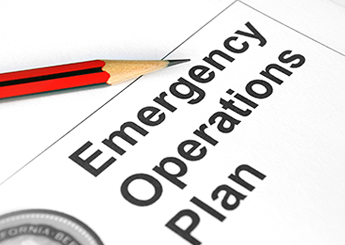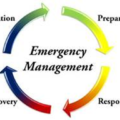An important feature of emergency operation plans is that they?
A. Provide a uniform response to all hazards that a community may face.
B. May be used in place of the national incident management system.
C. Is specifically tailored to recovery and contingency plans.
D. Are available electronically and may be updated throughout the incident.
The correct answer to the above question is A: they provide a uniform response to all hazards that a community may face.
The Emergency Operations Plan (EOP) provides the structure and processes that the organization utilizes to respond to and initially recover from an event. The operations required for planning, preparation, response and execution of operations required to deal with the emergency is known as Emergency Response Operations. The right emergency response strategy can prevent or mitigate casualties in myriad ways.
Over the years, researchers have identified eight fundamental principles of community emergency planning that can be used to increase a community’s level of preparedness, regardless of the amount of funding available:
- Anticipate both active and passive resistance to the planning process, and develop strategies to manage these obstacles. Emergency planning is conducted in the face of apathy on the part of some and resistance on the part of others. People are apathetic because they don’t like to think about their vulnerability to disasters. Alternatively people resist disaster planning because it consumes resources that could be allocated to more immediate community needs – police patrols, road repairs, and the like. Thus, disaster planning requires strong support from one of the following: the jurisdiction’s chief administrative officer; an issue champion, also known as a “policy entrepreneur,” who has the expertise and organizational legitimacy to promote emergency management; or a disaster planning committee that can mobilize a constituency in support of emergency management.
- Address all hazards to which the community is exposed. The plans for each hazard agent – flood, tornado, HAZMAT release – should be integrated into a comprehensive plan for multi-hazard emergency management. Emergency planners should conduct a community hazard-vulnerability analysis to identify the types of environmental extremes (floods, tornadoes, hurricanes, earthquakes), technological accidents (toxic chemical releases, nuclear power plant accidents), and deliberate incidents (sabotage or terrorist attack involving chemical, biological, radiological, nuclear, or explosive and flammable materials) to which the community has exposure. After identifying these hazards, emergency planners should examine the extent to which different hazard agents make similar demands on the emergency response organization; if two hazard agents have similar characteristics, they probably will require similar emergency response functions. Commonality of emergency response functions provides multiple-use opportunities for personnel, procedures, facilities and equipment. In turn, multiple use simplifies the emergency operations plan by reducing the number of functional annexes; it also simplifies training and enhances performance reliability during emergencies. Only when hazard agents have very different characteristics, and therefore require distinctly different responses, will hazard-specific appendixes be required for any particular functional annex.
- Include all response organizations, seeking their participation, commitment and clearly defined agreement. To be effective, emergency planning should promote inter-organizational coordination. Mechanisms should be developed to elicit participation, commitment and clearly defined agreement from all response organizations. These organizations would obviously include public safety agencies such as emergency management, fire, police and emergency medical services. However, they should also include potential hazard sources, such as HAZMAT facilities and transporters (pipeline, rail, truck and barge), and organizations that must protect sensitive populations, such as schools, hospitals and nursing homes. The reason coordination is required is that emergency response organizations of differing capabilities must nonetheless work in concert to perform the four major functions of responders – emergency assessment, hazard operations, population protection and incident management.
- Base pre-impact planning on accurate assumptions about the threat, about typical human behavior in disasters, and about likely support from external sources such as state and federal agencies. Emergency planning should be based on accurate knowledge of the threat, of likely human responses and of likely aid from external sources. Accurate knowledge of the threat comes from thorough hazard-vulnerability analyses. Accordingly emergency managers must identify hazards to which their communities are vulnerable, determine which geographical areas are exposed to those hazards (100-year floodplains and toxic chemical facility vulnerable zones), and identify the facilities and population segments located in those risk areas. Part of knowing the threat means understanding the basic characteristics of these hazards, such as speed of onset, scope and duration of impact, and potential for producing casualties and property damage. Planners and public officials also need accurate knowledge about likely human behavior in a disaster. Contrary to widespread belief – and common depictions in the media – people do not flee in panic, wander aimlessly in shock or comply docilely with the recommendations of authorities. Instead, disaster victims typically act rationally in terms of the limited information they have about the situation. Following impact, they are the first to search for survivors, care for the injured and assist others in protecting property from further damage. When they seek assistance, victims are more likely to contact informal sources such as friends, relatives and local groups than governmental agencies, or even such quasi-official sources as the Red Cross. Moreover, looting in evacuated areas is extremely rare, and crime rates tend to decline following disaster impact. Finally, concerned citizens believe they can best help the victims by entering the impact area to donate blood, food and clothing, even though doing so creates major problems of convergence.
- Identify the types of emergency response actions that are most likely to be appropriate. Sometimes the response that is usually the most appropriate one might not, in fact, be most suitable given the circumstances that arise in a specific event. Thus, emergency responders should be trained to implement the most likely responses to disaster demands, but they should also be encouraged to improvise on the basis of a continuing emergency assessment that identifies the appropriate response actions to the particular disaster well before those actions need to be implemented. In the highly charged atmosphere of imminent disaster, it is hard for an emergency manager to appear to be “doing nothing. However, it is important to recognize that the best action might be to mobilize emergency personnel and actively monitor the situation for further information rather than initiate unnecessary hazard operations, population protection or incident management actions. Thus, planning and training should focus on principles of response rather than trying to define overly specific procedures that contain a multitude of details.
- Address the linkage of emergency response to disaster recovery. It is increasingly recognized that there is no clear line between emergency response and disaster recovery. At any point after impact, some portions of the community will be engaged in emergency response tasks whereas others will have moved on to disaster recovery. Moreover, senior elected and appointed officials are likely to be inundated with policy decisions that need to be made to implement the emergency response at the very time they must plan for the disaster recovery. Consequently pre-impact emergency response planning should be linked to pre-impact disaster recovery planning. Coordination between the two plans will speed the process of disaster recovery by ensuring that the priorities for disaster recovery have been clearly established so that recovery actions can be initiated while the emergency response is still under way.
- Provide for training and evaluation of the emergency response organization at all levels – individual, team, department and community. Emergency preparedness also has a training and evaluation component. The first part of the training process involves explaining the provisions of the plan to the administrators and personnel of the departments that will be involved in the emergency response. Second, all those who have emergency response roles must be trained to perform their duties. Of course, this includes fire, police and emergency medical services personnel, but there also should be training for personnel in hospitals, schools, nursing homes and other facilities that might need to take protective action. Finally, the populations at risk must be involved in the planning process so they can become aware that planning for community threats is under way and be knowledgeable about what is expected of them under those plans. These populations need to know what is likely to happen in a disaster and what emergency organizations can and cannot do for them. It is also essential that training be followed by evaluation in the form of tests and exercises to determine whether it has been effective. Emergency drills and exercises provide a setting in which the adequacy of the emergency operations plan, standard operating procedures, staffing, facilities and equipment can all be tested as well. Further, multifunctional exercises (exercises that test a jurisdiction’s ability to perform all four emergency response functions – emergency assessment, hazard operations, population protection and incident management) facilitate interorganizational contact, allowing members of different organizations to better understand each other’s professional capabilities and personal characteristics. And multifunctional exercises also produce publicity for the broader emergency management process, which informs community leaders and the public that disaster planning is under way and preparedness is being enhanced.
- Recognize that emergency planning is a continuing process. Preparedness is a continuing process because conditions within the community change over time, conditions outside the community can change as well and the products of planning itself change. Conditions inside the community include hazard vulnerability, organizational staffing and structure, and emergency facilities and equipment. Conditions outside the community include federal regulations (witness the requirements for communities to adopt the National Incident Management System). The preparedness process results in some products that are tangible and others that are intangible – hard to document on paper and not realized in hardware. An example of such intangible products is the development of emergency responders’ knowledge about disaster demands, about their own emergency response roles and about other agencies’ capabilities. The potential for change in all three areas dictates that the emergency planning process detect and respond to these three kinds of changes and that all elements of emergency preparedness be audited periodically – and at least annually. ALSO READ: Six Functions of An Emergency Operations Center





